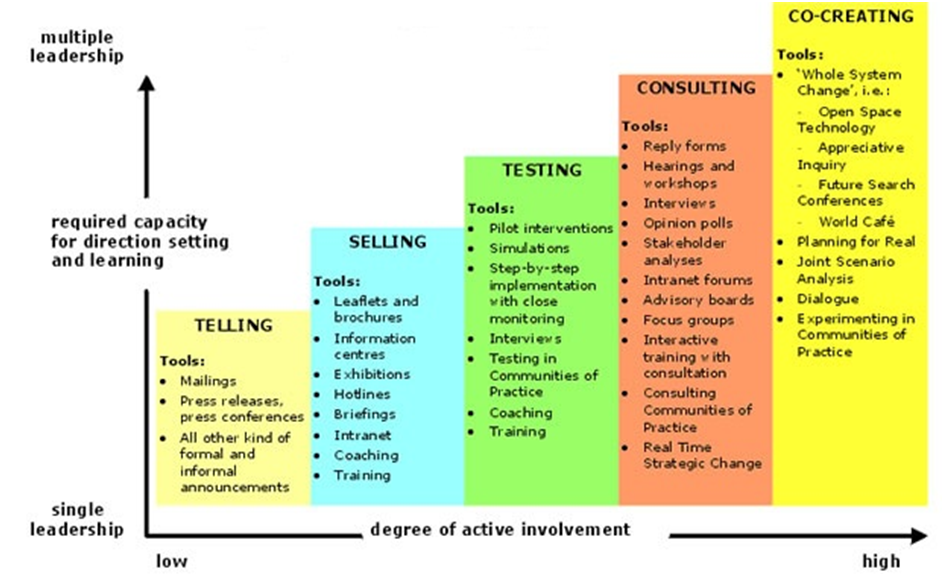Systems to Involve Stakeholders in the Planning of Change
 Organisational stakeholders of business need to be involved in planning strategic changes. The extent of involvement of each type of stakeholder in the planning of the change depends on a range of factors such as their influence, their importance, and the degree to which changes are going to affect them.
Organisational stakeholders of business need to be involved in planning strategic changes. The extent of involvement of each type of stakeholder in the planning of the change depends on a range of factors such as their influence, their importance, and the degree to which changes are going to affect them.
The extent of involvement of each type of stakeholder in the planning of the change is best explained by referring to the following graph.
Figure 1 Stages of stakeholder involvement in change processes
Source: Change Management Toolbook (2010)
On the basis of graph above, employees and managers as the main internal stakeholders at Company need to be involved in change planning process to the extent of ‘co-creating’.
The degree of involvement of company’s main external stakeholders – customers, on the other hand has to be limited to ‘testing’, whereas the company’s suppliers and shareholders need to be involved in the planning of change to the extent of ‘selling’
Additionally, “decision – makers may commission market surveys or mandate market research institutes so as to early perceive emergent stakeholder groups and their claims” (Zimmermann, 2011, p.225) in order to reflect their viewpoints regarding the change initiatives.
It is important to note that the system to involve stakeholders in the planning for change presented above is only a general framework and the extent of involvement of stakeholders may differ in each individual circumstance depending on the nature of the proposed change.
Change Management Strategy with Stakeholders
Business’s change management strategy with stakeholders primarily depends on the level of power of each stakeholder category, as well as, the level of their interest on the change proposal. As a general rule, Company is suggested to deal with its stakeholders on the basis of the following figure as it has been suggested by Murphy and Willmot (2010):
Figure 2. Power/interest grid for dealing with stakeholders
Source: Murphy and Willmot (2010).
According to the figure above, Business’s stakeholders with high power and high level of interest such as employees and shareholders need be closely managed in relation to change initiatives. High level of power and low level of interest stakeholders, such as customers, on the other hand, need to be kept satisfied by the company management.
Another stakeholder category that has low power but high level of interest, such as suppliers need to be kept informed about the progress of change initiatives through various communication channels. The type of stakeholders that have low level of power and low interest in changes within Boots, such as general public need to be monitored with minimum efforts and resources.
Evaluation of Systems to Involve Stakeholders in Change Planning
The proposed system for Company to involve stakeholders in change planning (Figure 1) represents an efficient method for developing an effective change plan and contributes to its efficient implementation. The system proposes the involvement of employees and managers in change planning process to the extent of ‘co-creating’ that involves engaging in in-depth dialogue and developing joint scenario analysis. The rationale behind such a great attention to employee viewpoints relates to close familiarity of this specific type of stakeholders with organisational issues.
The degree of involvement of Business’s main external stakeholders – customers, on the other hand is decided to be limited to ‘testing’ that involves simulations, pilot interventions, and testing, because customers approach the issue from a narrow viewpoint i.e. they expect greater value with no considerations to resources required (Pride et al, 2009).
The proposed system for Company states that company shareholders need to be involved in the planning of change to the extent of ‘selling’, i.e. they need to be informed about change proposals through various communication channels.
References
Murphy, D.J. & Willmott, H. (2010) “Organisation Theory and Design” Cengage Learning
Pride, W.M, Hughes, R.J & Kapoor, J.R. (2009) “Business” Cengage Learning
Zimmermann, N. (2011) “Dynamics of Drivers of Organisational Change” Springer Publications


